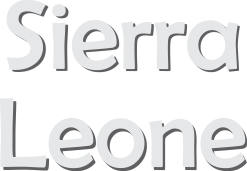
Sierra Leone or officially known as ‘Republic of Sierra Leone’ is country located in West Africa. Sierra Leone shares it borders with Guinea to the northeast, Liberia to the southeast and Atlantic Ocean to the southwest. Sierra Leone derived its name from a Portuguese word ‘Serra Leao’, which means ‘Lion Mountain Range’. Freetown is the capital and the largest city of Sierra Leone. The terrain of Sierra Leone primarily comprises mountains and plateaus with densely forest regions. Loma Mansa is the highest region in the country and Rokel River is the most important river in the country.
Freedom of religion is provided by the constitution of Sierra Leone to all its citizens. Individuals are allowed to practice and preach any religion as per their beliefs. The government strongly protects this right and strict action is taken against the people who violate this right. Sixty percent of the country’s population comprises followers of Islam, with a significant minority of 20%–30% followers of Christianity. In the forest and underdeveloped areas about 5%–10% of the people practice indigenous animist beliefs. The Fulahs and Mandikas from the Muslim countries to the north established Islam in Sierra Leone long before Christianity. There are over fifteen different religious faiths practiced in the capital city and there are seventy churches in the capital city.

The climatic condition in Sierra Leone is usually hot and humid throughout the year. The average temperature in the country usually is 26° C and it varies throughout the year from 26° C to 36° C. The coastal regions of the country remain cooler due to the sea breezes. During the months of December and January the dry and dusty Harmattan wind blows from the Sahara, the heavy amount of dust limits the visibility and blocks the sun for days. Rainfalls start during the month of May and last until November. Rainfall can be torrential during these months. In the month of August, during the rainy season there is a period called the ‘seven day rainfall’ wherein the rain falls for a period of seven days straight without any interruption. The climatic conditions in the month of October to March are hot but they are much more pleasant as they are comfortable and dry.

Harmattan Winds
The food culture of the country is rich and deep. Rice is among the staple diet and is consumed virtually at every meal by the people of Sierra Leone. Rice is prepared with a variety of sauces with the combination of many key ingredients including hot pepper, potato leaves, tomatoes, cassava leaves, onions, eggplants, beef, okra and fish. A wide variety of fruits and seafood is consumed by the people of Sierra Leone, but they are just considered as snacks. ‘Joll of Rice’ is their traditional dish, in which the rice is fried with beans and then served with spicy onion and garlic sauce. Among the deserts, ‘Coconut Cake’ is most preferred by the people.

Joll of Rice
Education is legally required and compulsory for all its citizens. It comprises six-year primary education and three years of secondary education. Despite of education being compulsory, implementation in this field is impossible due to shortage of schools and professional teachers. The Sierra Leone Civil War destroyed over twelve hundred schools, due to which now two-third of adult population is illiterate. Modernization is required for all the schools in urban and rural areas as they are old and require redevelopment. There are three universities in this country: Fourah Bay, Fatima Institute and Njala University. Over the years, the government has started teacher-training schools and colleges to improve the education system.

Fourah Bay College
The Sierra Leone Civil War had a devastating effect on the people’s physical and mental health conditions. Since the war ended, the medical facilities are extremely poor and limited. Many communities in the country have poor access to water, whereas the rural population usually relies on rivers or swamps, which are usually, dirty. This has given rise to outbreak of many waterborne diseases namely: diarrhoea, hepatitis A, and cholera. Among the most concerned diseases, include HIV, Lassa fever, yellow fever and malaria. Sierra Leone has the highest rate of maternal and child mortality in the world. The government and other foreign aid organizations provide health care in the country. Primary health care is free for pregnant and lactating women. Mental health care does not exist at all in this country, so some patients try to cure themselves with the help of traditional healers.

Agriculture remains the main occupation of the people of rural areas. Coffee, cocoa and peanuts are the major crops grown and exported to generate and help contribute towards the economy. There are small-scale industries that produce commercial goods like cloth, cigarettes, pans, pots and mats. The market trade is mostly dominated by women selling foodstuffs. Due to mismanagement, corruption and smuggling only a small part of the benefit is received by the national economy from the official exports of bauxite, gold and diamonds. Sierra Leone trades in illicit gems, known as ‘blood diamonds’ or ‘conflict diamonds’. The major industries that help towards the economy usually produce flour and rice. Mining and Tourism were the dominant industry in the early years but due to the civil war, both have been affected on a large scale.



